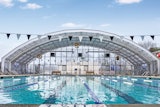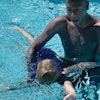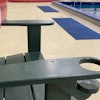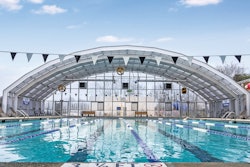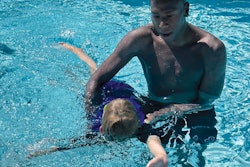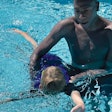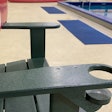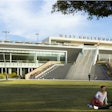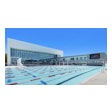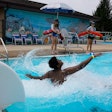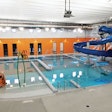Overseeing Leisure Pools

By providing innovative and interactive activities to maintain users' interest, leisure pools are a big improvement over the traditional flat, rectangular swimming pools of the past. But while the leisure pool concept - with its play structures, slides, fountains, spas and lazy rivers - has proved successful in increasing attendance and revenue in community after community, it does present a number of supervision and management challenges:
• The increased bather load common at leisure pools heightens the need for lifeguards, facility managers and security personnel to be extra vigilant. This is especially so because the patrons of leisure facilities are predominantly children.
• Architecturally, rectangular pools lend themselves well to establishing lifeguard stations and zones of responsibility. Their symmetrical nature allows for easily identified zone markers. However, the leisure pool - with its various shapes, levels, play apparatus and activities - does not provide easily identifiable zones. Blind spots in lifeguard surveillance may be prevalent due to these same difficulties, a problem that may require rethinking traditional practices of where and how lifeguards are used (such as placing the lifeguard in the water rather than on the deck). Increased numbers of lifeguards may be needed to provide adequate coverage to those areas not readily seen.
• Patrons who attend traditional pools tend to fit a profile. They are often older, intent on swimming laps, and are repeat customers. These users require little orientation to the facility or its rules and usually can be relied on to have a modicum of swimming ability. Leisure pool patrons do not fit this profile - these users are at the facility seeking to be entertained. They may be visiting the facility for the first time and require orientation to rules, policies and facility layout. Their level of swimming ability is also unknown, as guest turnover is extremely rapid. Leisure facilities tend to attract younger visitors, raising the twin concerns of parental supervision and delinquency.
• The physical and chemical characteristics of the leisure pool are also significantly different. The concerns of moving water, hot water and high bather load may change the water chemistry, requiring modified chemical treatment, application procedures and treatment schedules. Water chemistry tests may also need to be done at several different locations in the facility, as water chemistry may be vastly different in areas of still water compared to those with a current.
SUPERVISION The presence of trained lifeguards at a leisure pool is a necessity, not a luxury. Guest safety must be the primary concern of management at every aquatic facility, and lifeguards are at the forefront of this effort. Lifeguards provide a preventive measure against patrons injuring themselves from actions they may be unaware are dangerous. They also are trained to respond in cases of injury and medical or drowning emergencies.
A lifeguard's basic qualification is a current lifeguard training certificate and a "CPR for the Professional Rescuer" certificate. Lifeguard training is administered by several nationally recognized agencies including the American Red Cross, the YMCA of the USA, and Ellis and Associates. The American Red Cross, American Heart Association and the National Safety Council all offer CPR instruction. Specialty training dealing with aspects of leisure facilities (such as water slides and wave pools) is also available from some certifying agencies. In the case of the American Red Cross, it is offered in addition to the basic lifeguard certificate. In the case of Ellis and Associates, it is included in the basic course.
Recent technological advances have boosted the range of skills required of lifeguards. The ease and proliferation of oxygen and defibrillation training have made these implements increasingly common at commercial pools. The American Red Cross, National Safety Council and Ellis and Associates offer certification in defibrillation and oxygen administration. Each course is approximately four hours in length and results in an additional certification.
In addition, training in preventing disease transmission and blood-borne pathogen prevention is not only important, but is required under Occupational Safety and Health Administration guidelines for employees at risk of exposure, including lifeguards. This course is approximately three hours long and results in a lifetime course completion certificate. OSHA, the American Red Cross and the National Safety Council all offer certification in this area.
Lifeguards reporting for work on the first day have received basic and generic instruction from their training program on how to perform aquatic rescue. However, they likely aren't aware of the particular characteristics of their new place of employment, or its patrons. Providing lifeguards with specific information about the facility is management's responsibility. Facility tours should be conducted; topics for discussion should include patrons' characteristics (such as predominant age and swimming ability), and the location of light switches, emergency equipment and telephones. New lifeguards should also receive a facility-specific training manual that includes rules and regulations as well as emergency procedures.
Prior to beginning work, aquatic staff should be given the opportunity to use all rides and recreational equipment at the facility. This allows them to understand the hazards of the equipment as well as how it works. They are thus better able to instruct patrons in the use of the rides as well as warn of potential dangers.
Once lifeguards receive their preservice training, they should receive regular in-service training to refresh their skills and to remain current. Auditing staff, which involves a member of the supervision team visiting each lifeguard during a shift, is one method of assessing lifeguards' skills. Each lifeguard is taken from the stand, asked to perform CPR on a mannequin and asked to perform a simulated rescue. These spotchecks reinforce basic skills and serve to keep staff alert. Audits should not begin until staff is notified that they will be spot-checked. Lifeguards who fail audits should be suspended from work until they are able to satisfactorily complete the test.
Emergency situations encountered at aquatic facilities may require coordination between lifeguards, EMS crews, security, local law enforcement and the fire department. Running an emergency drill that incorporates all of these agencies will allow for smoother response during an actual emergency. Ironing out details - where to meet EMS personnel, what entrances are large enough to admit a gurney and where to park emergency vehicles - is helpful to both EMS and facility staff.
The fully prepared lifeguard should also have available a range of specialized equipment. One of the most basic pieces of equipment is the lifeguard waist pack. This nylon carryall should contain a rescue-breathing barrier such as a pocket mask or microshield, two pairs of latex gloves, gauze pads, tape, adhesive bandages and roller gauze. This allows a lifeguard to respond immediately to any emergency without leaving the victim to retrieve first-aid equipment. Lifeguards should be required to wear their waist packs at all times.
Once training in oxygen and defibrillation has been completed, the facility should provide actual defibrillators for lifeguards' use. Maintaining accessibility yet security for these devices is a fine balance. They need to be placed in an area where they can be used as needed, such as the lifeguard staff office or security office. They should be kept under lock, but with the keys accessible to lifeguards and other trained staff.
Another piece of specialty equipment is the "jump" first-aid kit, which is portable and heavily stocked with supplies. This allows treatment to be taken anywhere a patron is seriously injured. These kits should be water resistant, tough and lightweight. Paramedic-style kits available from safety supply houses are recommended.
Two-way radios are also a valuable resource for leisure facilities. They allow for the quick summons of security staff in the event of a confrontation, as well as EMS personnel during an emergency. They also help facilitate the flow of information for more simple tasks such as summoning maintenance for replacement of supplies or asking for an extra guard from the office on busy days. In order to be useful, staff must be trained how to operate them, and unnecessary radio traffic must be kept to a minimum.
Hand-held flashlights are essential for indoor facilities. Preferably, these lights will be waterproof, lightweight and extremely powerful. This will allow for easier evacuation of patrons during a power outage, and will help ensure that no patrons are left in the pool. Flashlights should be attached to the lifeguard stands, with an additional one placed in the staff office; they should be checked weekly and batteries replaced at least annually.
ADMINISTRATION The accident report form is one of the simplest yet most important pieces of paper a facility can produce. This form is used to record important information about a patron in the event of an accident. The form should include the patron's name, home address and telephone number, type of accident and the precise location where it happened. Other essential information includes what treatment was administered and whether the victim was given further treatment or referred to professional medical care. The date and time of the accident, and the names of witnesses and staff on hand should also be recorded on the form, along with a space for narrative. Forms involving injured minors should be kept until five years beyond the minor's 18th birthday. For adults, forms should be maintained for five years from the date of the accident. Accident reports are a facility's form of liability protection. Personal opinions should never be included.
The accident plotting board is a visual aid used in conjunction with accident report forms to plot areas of high accident occurrence within the facility. Accident report forms dating from most recent and extending back several years are collected for a given facility. Each type of accident is given a letter or code (for example, ND for near drowning, CT for cut). An enlarged diagram of the pool and deck is prepared and placed on poster board, and the various accident codes are plotted on the diagram. This allows facility management to visualize where in the facility the majority of accidents are occurring and to move lifeguard stations to the area of high accident occurrence. It also helps justify staff additions and identifies areas of the facility to be repaired.
The incident report is closely akin to the accident report. It is used to record important non-accident information, such as thefts, break-ins, fights and public-relations information. The form should capture information regarding the appropriate parties' names, the date and time of the incident, the location, witnesses present and any action taken. Space should also be provided for any narrative or statements given by witnesses, staff or affected parties. If need be, these forms can be copied when completed and forwarded to local law enforcement. In the event that law enforcement becomes involved, the assigned case number or complaint number should be obtained and logged on the facility's copy of the form.
Tracking bather loads is of critical importance to the facility from a management standpoint. This involves counting the number of bathers utilizing an aquatic facility during each hour it is open for use, something that can be done by staff physically counting patrons and recording the totals on a log sheet or by using turnstile counts in a pool-only facility. Bather counts allow management to determine their times of highest use for the best scheduling of available staff. They may also help management to determine that some times of the day are not cost-effective to operate the pool. This information will permit them to alter their business and marketing plan accordingly.
The leisure facility is an attractive enticement for patrons - and nonpatrons. Some members of the public will attempt to illegally enter the facility during or after operating hours to use it without paying or for the purpose of theft and vandalism. Outdoor facilities can combat this problem with adequate fencing that is secured to the ground and extends a minimum of 8 feet high. Access should be restricted through a centrally controlled entrance point. Service and emergency vehicle entrances should be locked when not in use. Pole-mounted halogen lighting should be placed around the perimeter to discourage nighttime entrances. Security teams present during the day provide a deterrent to theft and disruption, while giving patrons a sense of security. At night, security personnel can safeguard management's investment in the facility.
Managers of indoor pools should ensure that doors and locks are sturdy and functioning properly. The addition of 24-hour looping tape security cameras can assist in deterring theft, and in apprehending offenders in the event it does happen. For best results, security personnel should be trained, bonded and hired from reputable agencies. They should work closely and in conjunction with local law-enforcement agencies. Frequent security audits, particularly of cash handling procedures, are essential.
MAINTENANCE A well-maintained facility not only saves management money by extending the life of the facility, but more than recoups maintenance costs through attracting patrons, special events and rental contracts.
A properly maintained facility should be inspected daily. Basic inspections should include a safety and operational assessment of all fixtures, such as diving boards, slides, swings, flumes and toys. Inspection of these items should focus on wear, damage and breakage. Other items to be included are safety equipment, lighting, doors and locks, the pool deck and the pool basin. A facility-specific checklist should be developed and used for simplicity. The inspection should be carried out prior to opening each day and the sheet filed. The inspection allows facility operators to spot safety and maintenance concerns before they result in injury to patrons or staff.
The cleanliness of the leisure pool can be the one element that determines whether a customer will return to the facility or caution friends to stay away. A facility with clean, appealing changing and lavatory facilities and sparkling water will make the patron feel at home and inclined to return. Creating and adhering to a daily cleaning schedule will help maintain the desired level of sanitation and presentation. The schedule should include daily disinfecting of the pool deck and a minimum of twicedaily thorough cleaning of lavatories.
Lavatories are an area of high concern due to the possibility of disease transmission and the relative importance placed on them by patrons. Lavatories should be checked for cleanliness and paper supplies hourly, more often in high-volume facilities. Shower rooms should also be disinfected daily, with drains inspected for clogs. Liquid bulk soap should be placed in showers, as it is more sanitary than bars, and dispensers should be checked twice daily. Trash cans should be checked hourly in high-use facilities.
The maintenance schedule should be posted for cleaning crews to use. Duties should be divided among shifts and individuals. Some duties, such as deck disinfecting and shower cleaning, are best performed when the facility is closed and patrons will not be disturbed.
Water chemistry tests are another element of facility maintenance that require uniformity and regularity. Water chemistry tests consisting of chlorine, pH and temperature should be conducted at least each morning, noon and evening for indoor pools. Outdoor facilities need to be checked as frequently as hourly for pools with high bather loads coupled with sunlight and humidity. These factors can reduce chlorine content in pools rapidly, assisting in the spread of disease and adding to dangerous turbidity of the water.
Weekly tests for items such as total dissolved solids, calcium hardness and alkalinity should also be carried out. These show the pool operator the effect that the pool water is having on the facility and allow him or her to take early steps to correct problems.
Individual states regulate aquatic facilities within their borders through their respective state bathing codes. Items included in the bathing code may be qualifications and requirements for lifeguards, water chemistry specifications, record-keeping instructions and licensure requirements. Common agencies that carry out this regulatory function include the State Department of Health, the State Department of Natural Resources, and the local water and sanitation departments. Aquatic facility managers are required to be aware of these regulations and to adhere to them. States frequently inspect facilities, and failure to have a state swimming pool license (if required) or to pass the inspection can result in closure of the pool.
OSHA is the federal agency charged with overseeing the health and wellbeing of employees in the workplace. In the aquatic environment, management must be aware that lifeguards and pool maintenance staff work with and around chemicals that may be harmful. OSHA requires that proper safety equipment be made available to employees in these circumstances. Protective equipment needed may include eye guards, rubber gloves, aprons and protective breathing devices. These protect the employee from splashed chlorine or acid, and from inhaling dust and fumes from soda ash, chlorine, diatomaceous earth and other chemicals. Written instructions and verbal training should be provided to employees regarding the safe handling and disposal of pool chemicals.
Lifeguards and other safety personnel must also be provided with personal protective equipment against exposure to blood-borne diseases. Equipment in this category includes pocket resuscitation masks, latex gloves, eye protection and gowns. Workplace safety measures, such as required use of sharps containers (red plastic buckets used to discard needles, glass and other potentially blood-contaminated sharp objects) and biohazard bags, should also be implemented. A biohazard protocol regarding what to do in the event of exposure to blood or bodily fluids should be developed and disseminated. Training from a nationally recognized agency such as the American Red Cross or National Safety Council should be provided. All employees at potential risk of exposure should be informed of their opportunity for hepatitis vaccinations. Records of both training and vaccinations should be kept in the employee's file.
Proper management of a leisure aquatic facility is hard work. Balancing the safeguarding of patrons, compliance with regulations and making a profit is a difficult task. The leisure pool is a specialized aquatic facility that requires specific management strategies. The discerning manager will recognize the differences between the leisure pool and traditional pools, and will respond rapidly to meet the specific challenges.









